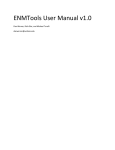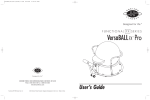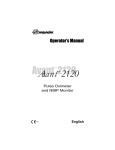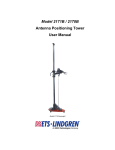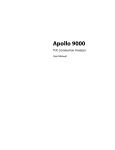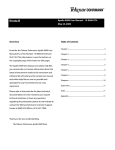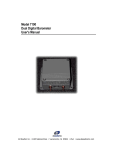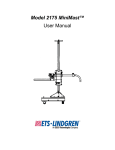Download Airflow RB3 Product manual
Transcript
Model #RB3-065/035 Product Manual ©Empire Robotics, Inc. R20140519 Table of Contents 1. Overview ........................................................................................ 1 2. Safety Information ......................................................................... 2 3. Packing List and Terminology..................................................... 4 4. Technical Specifications ................................................................ 5 5. Operating Requirements .............................................................. 6 6. Installation ...................................................................................... 9 7. Performance Confirmation & Diagnosis .................................. 12 8. Programming and Operation Recommendations ................... 15 9. Maintenance ................................................................................. 24 10. Troubleshooting .......................................................................... 25 11. Technical Support........................................................................ 25 12. Warranty ....................................................................................... 26 13. Notes ............................................................................................. 27 1. Overview Thank you for purchasing a VERSABALL® Gripper from Empire Robotics. VERSABALL® utilizes Empire’s proprietary granular jamming technology to achieve flexible and adaptive gripping through rapid hardness modulation. For video demonstrations of the gripping abilities of this technology visit www.empirerobotics.com. This product manual contains important safety, installation, and usage information to help you get the most out of your VERSABALL® Gripper. Because your VERSABALL® represents a unique new technology, we highly recommend reading this manual thoroughly. If you have additional questions not covered by this document or if you need additional help setting up or operating your gripper, contact our technical support at [email protected]. At Empire Robotics we continually strive to deliver quality products for the industrial automation market. Your feedback is appreciated and may be provided at [email protected]. Thank you for choosing Empire Robotics! Model #RB3-065/035 1 R20140519 2. Safety Information This model #RB3-065/035 VERSABALL® Gripper is a research development unit, and therefore has no expressed or implied safety guarantee. Specific safety risks may include but are not limited to the following: General hazards: A. Your model #RB3-065/035 VERSABALL® Gripper contains rigid aluminum components. The green spherical head of the gripper also becomes very hard when its vacuum-jammed state is induced. The gripper is therefore capable of causing significant bodily harm if it strikes a person (e.g. when in use on a fastmoving robot arm). It is recommended to operate the gripper only after performing an appropriate risk assessment. B. Your model #RB3-065/035 VERSABALL® Gripper is not rated for food handling operations. We therefore do not recommend using this gripper for handling any food items. C. Your model #RB3-065/035 VERSABALL® Gripper should be treated as a piece of industrial equipment. Because of the variety of potential safety hazards described here, we do not recommend that children use this device. Balloon membrane hazards: D. Your model #RB3-065/035 VERSABALL® Gripper contains mechanisms to help prevent overinflation and the possibility of subsequent burst. However, as described in Section 6, you have the ability to override the overinflate protection if needed depending on your application. Exercise additional caution whenever you override the overinflation protection. E. The outer balloon membrane of your model #RB3-065/035 VERSABALL® Gripper consists of a proprietary blend of elastomeric materials and may contain natural rubber latex. Those with latex allergies should avoid direct skin contact with the balloon membrane. Model #RB3-065/035 2 R20140519 Granular material hazards: F. Your model #RB3-065/035 VERSABALL® Gripper contains redundant filtering mechanisms to prevent dust particles from entering the atmosphere. In normal use, the model #RB3-065/035 VERSABALL® Gripper emits trace amounts of dust into the atmosphere. These levels have been measured to be well below the OSHA recommended limits for respirable dust and nuisance dust, as documented in the material’s MSDS. If your gripper overinflates, violently collides with a sharp object, is used beyond its intended service life, or experiences some other unforeseen failure, the granular material contained within the gripper could be released into the environment. The grains are non-toxic and can be cleaned up with a dustpan or vacuum cleaner. During such a failure, some nuisance airborne dust may also be released, which in turn could lead to the unlikely but possible event of mechanical lung irritation (silicosis). Dampening the granular material with water spray will reduce the risk of lung irritation during cleanup. Similarly, if grains somehow reach your eyes, they could potentially cause mechanical eye irritation. It is advised to wear safety glasses if you are working in very close proximity to the gripper – especially if you choose to override your overinflate protection. If eye irritation occurs, gently rinse your eyes with water. Model #RB3-065/035 3 R20140519 3. Packing List and Terminology Your model #RB3-065/035 VERSABALL® gripper is shipped fully assembled and ready to be installed. The gripper has four primary parts as shown in Figure 1 (adapter plate, base, large head, small head). Figure 1 Four #10-24 x 1/2" cap screws attach the adapter plate to the base, and four draw latches attach the base to the head. The draw latches can be released to disengage the head (this is only necessary if the gripper head needs changing or replacement). To reengage the head, ensure that the flat plates of the base and head meet flush, then manipulate the draw latches to secure the head. Your model #RB3-065/035 VERSABALL® Gripper is also shipped with tubing, push-to-connect fittings, and a diagnostic analog vacuum gauge. Use of these accessories is described Sections 5 and 6. Model #RB3-065/035 4 R20140519 4. Technical Specifications This model #RB3-065/035 VERSABALL® Gripper is a research development unit. Some technical specifications listed in this section only represent expected values based on testing with earlier prototypes. No expressed or implied guarantee of these technical specifications can be made at this time. For best practices on how to achieve maximum performance with your gripper, see Section 8. Small Head Large Head Head diameter 3.5 in 6.5 in Base weight 2.1 lb Head weight 1.4 lb 5.5 lb Total gripper size 5.0 x 5.0 x 4.5 in 6.5 x 6.5 x 7.5 in Rated supply air pressure 80 psi Minimum required air flow* 23 SCFM Air use per grip ~ 0.02 ft3/grip ~ 0.1 ft3/grip Head life cycle** 20,000 – 60,000 grips Operating temperature ~ 33° F to 160° F Max vertical payload** ~ 10 lb ~ 20 lb Max tangential payload ~ 20 lb ~ 40 lb Retention (pull-out) force** ~ 0 – 10 lb ~ 0 – 20 lb Required minimum contact ~ 10 – 15 lb ~ 15 – 20 lb (pressing/deformation) force** Pinching pressure on object** ~ 5 psi ~ 7 psi Grip time 0.1 s 0.7 s (evacuation to 20 inHg) Sealed vacuum hold time < 0.5 inHg loss per 30 seconds Grip release time ~ 0.15 s ~1s Placement precision (linear) ~ ± 0.03 in Placement precision (angular) ~ ± 2° Target object size range ~ 50% head diameter +/- 20% * with supply hose open to atmosphere (about 7.1 SCFM with gripper connected) ** depends heavily on object geometry, surface properties, and programming practices. See Section 8 for details. Model #RB3-065/035 5 R20140519 5. Operating Requirements The most critical aspect of the installation process is air. Without proper air supply and valving, your VERSABALL® can still be configured to function, but operation speeds will be significantly reduced and you’ll have to contact our customer support for some help optimizing the performance of the gripper with the available air supply. Your model #RB3-065/035 VERSABALL® Gripper has three pneumatic ports as shown in Figure 2, and requires two pressurized air inputs. When your gripper arrives, the auxiliary port will come with a diagnostic vacuum gauge installed, and the release port will come with a flow control valve installed. Note: supplying pressurized air at the grip port generates a vacuum within the gripper. Do not supply a vacuum line at this port; the gripper accepts pressurized air only. We recommend the following setup: Figure 2 At the grip port: We recommend installing tubing with 1/2" outer diameter and 5/16” inner diameter. The 1/2" diameter push-to-connect fitting installed at the grip port is rated for polyurethane tubing (with a hardness of Shore A 88-97) and nylon tubing. A length of appropriate tubing has been included in your shipment, and McMaster-Carr p/n 5648K33 is also suitable. We recommend that the length of this tubing should not exceed 10 ft. Upstream of the grip port, some method of valving is required. An electric solenoid valve rated for high flow rates and with a minimum Model #RB3-065/035 6 R20140519 port size of 3/8" NPT is recommended. Empire Robotics uses Clippard p/n MME-33WES for internal testing. Best practices for timing the opening and closing of the valves are provided in Section 8. At the release port: We recommend installing tubing with 1/4" outer diameter and 3/16" inner diameter. Other configurations are not recommended; larger diameters may result in rupture of the gripper and smaller diameters adversely affect the inflation speed of the gripper. The 1/4" diameter push-to-connect fitting installed at the release port’s flow control valve is rated for polyurethane (with a hardness of Shore A 88-97) and nylon tubing. A length of appropriate tubing has been included in your shipment, and McMaster-Carr p/n 5648K25 is also suitable. We recommend that the length of this tubing should not exceed 10 ft. Upstream of the release port, some method of valving is required for this hose as well. An electric solenoid valve with a minimum port size of 1/4" NPT is recommended for the release port. Empire Robotics uses Clippard p/n MME-32QES for internal testing. Best practices for timing the opening and closing of the valves are given in Section 8. Upstream air supply requirements: For optimal performance, a pressure of 80 psi should be supplied. The pressure must not exceed 90 psi. All pneumatic components (couplings, fittings, regulators, electric valves, etc.) should be rated for flow rates well in excess of 25 SCFM. All piping and tubing should have an outer diameter of at least 1/2" and an internal diameter of at least 3/8". Large distances or numbers of pneumatic components increase the resistance to flow in an additive manner. Therefore, when long distances or large number of components exist upstream, components rated for higher flow rates as well as larger tubing and pipe diameters may be required. Moisture and other contaminates in the air lines can negatively influence the performance of your gripper, so filtering and dehumidifying your air supply is recommended. We recommend Model #RB3-065/035 7 R20140519 Clippard p/n MMF-4W-F5 if you have no other filtering or moisture separation equipment in place. Testing your air supply: Test your air supply to ensure proper pressure and flow rate are available for the gripper. Simply checking the rating on your compressor is often insufficient due to restrictions, distance, and other losses as mentioned previously. Utilizing a pressure gauge and flow meter is recommended. At the point of entry into the grip port (through the 1/2" diameter tubing immediately prior to entry into the device), your air supply should be capable of providing 80 psi with a flow rate of 23 SCFM. Measure these when the hose is disconnected from the gripper. When the hose is connected to the gripper and air is flowing, this should correspond to a flow rate of approximately 7.1 SCFM. These air requirements may sound somewhat complicated, but most shop air supplies will already meet all these requirements at the nearest pipe. Supplying your gripper with adequate airflow is then simply a matter of ensuring that appropriate fittings and tubing are used between the pipe and the gripper. Again, if you are unable to provide proper air supply and valving your VERSABALL® Gripper can still be configured to function, but operation speeds will be significantly reduced and you’ll have to contact our customer support for some help optimizing the performance of the gripper with the available air supply. Model #RB3-065/035 8 R20140519 6. Installation Make sure that your robot is powered down and in a safe position before installing your gripper. Also turn off the air supply at an upstream shut-off valve during installation. Your model #RB3-065/035 VERSABALL® Gripper comes with an adapter plate and mounting screws in order to easily interface with a variety of industrial robot arms. During shipping the adapter plate is attached to the gripper. To begin installation, first remove the adapter plate from base of the gripper by removing the four radially located #10-24 x 1/2" cap screws as shown in Figure 3. Figure 3 Next, determine which set of holes in the adapter plate matches the bolt pattern on your robot arm (generally 4 mounting screws will be needed). A drawing of the bolt patterns provided on the gripper’s adapter plate is shown in Figure 4. Model #RB3-065/035 9 R20140519 Figure 4 Align the adapter plate with your robot’s wrist and install using the M4, M5, or M6 screws provided (see Figure 5). Figure 5 Reattach the base to the adapter plate using the four #10-24 x 1/2" cap screws (again see Figure 3). This step is a bit easier if you can flip the robot’s wrist to face upward. Be sure to align the base so that the pneumatic ports are well situated for connection to your air source. Model #RB3-065/035 10 R20140519 Cut the provided air tubing to an appropriate length, making sure to leave enough length to allow full range of motion of the robot. Install the tubing with the push-to-connect fittings as shown in Figure 6. Figure 6 If you separated the base and head pieces prior to installation, reconnect them now. A fully installed gripper is shown in Figure 7. Figure 7 Model #RB3-065/035 11 R20140519 7. Performance Confirmation & Diagnosis Your model #RB3-065/035 VERSABALL® Gripper comes with a diagnostic vacuum gauge installed at the auxiliary port. We recommend the following procedure to confirm your gripper’s performance immediately following installation. We recommend using the large head for this test. Repeat the process below whenever you change to a different head size. However, repeating this process is not necessary when simply replacing a worn head with a newer head of the same size. 1. The flow-control valve installed at your gripper’s release port is shipped fully closed. Check that the valve is closed by turning clockwise as shown in Figure 8. 2. Next, open the upstream solenoid valve connected to the gripper’s release port, making sure you are able to close this valve again quickly. No air should flow because the flow-control valve is fully closed. 3. With the pressure on, slowly open the flow-control valve by turning counter-clockwise so that air can begin flowing into the gripper. Mechanisms within the gripper will limit the expansion of the balloon head and prevent overinflation. Continue opening the flow-control valve until the gripper’s balloon head reaches a steady-state enlargement of about 10%. Use the black locking-nut to lock the flowcontrol valve in this position, turn off the positive pressure, and continue to the next step. Model #RB3-065/035 12 R20140519 Figure 8 4. While watching the included vacuum gauge installed at the gripper’s auxiliary port, open the valve connected to the gripper’s grip port and observe the vacuum generation speed. You should be able to observe performance very similar to Figure 9. Figure 9 5. Switch back and forth between opening the grip and release ports several times to make sure performance similar to Figure 9 is achieved. Detailed measurements are not necessary. Simply confirming that the gripper reaches ~25 inHg vacuum in less than 1.5 seconds is sufficient. Model #RB3-065/035 13 R20140519 If the ultimate vacuum level does not reach at least 22 inHg, either the upstream air supply is restricted or there is a problem with the device. The included vacuum gauge is only capable of ±3 inHg accuracy, which is sufficient for simple install verification. 6. Adjusting the flow-control valve on the release port will require some tuning. A tradeoff exists between inflation (object release/ejection) speed and overinflation protection. With the valve fully open, you can override your overinflate protection to achieve the fastest ejection speeds. This is a perfectly fine way to use your gripper, but comes with obvious additional risk. Model #RB3-065/035 14 R20140519 8. Programming and Operation Recommendations VERSABALL® Grippers utilize a technology known as granular jamming to grip and release objects through rapid hardness modulation. You can see this same effect if you buy vacuum-packed coffee at the grocery store – hard as a brick until you release the seal, whereupon the particles will flow more like a fluid. It can be useful to keep this concept in mind when you are working with your gripper – vacuum-pack the gripper to so that it will become rigid and grip onto an object, inflate the gripper to release the vacuum seal and soften the gripper for contact with the next object. This process is shown in Figure 10. Figure 10 When gripping a target object, VERSABALL® Grippers may achieve retention forces by three independent mechanisms, as shown in Figure 11. Shown on the left, friction forces from pinching are the most common. These forces develop during the small volume contraction that occurs when the gripper is vacuum-hardened. In the center, entrapment or capture of the object can occur if the gripper can wrap around some geometric feature. This mechanism is less common, but can increase holding force dramatically when it occurs. Finally on the right, a vacuum-suction force can develop in the sealed gap that forms between the gripper and a smooth object. This mechanism is also less common, but can provide dramatic increases in holding force as well. Model #RB3-065/035 15 R20140519 Figure 11 Your model #RB3-065/035 VERSABALL® Gripper does not contain any electrical components. The gripper is controlled with usersupplied valves at the gripper’s grip and release ports. This section proceeds with recommendations based on a typical installation (with the VERSABALL® Gripper mounted on a robot arm and controlled by two independent solenoid valves). Modifying these recommendations for other setups should be straightforward. When programming, always use a “pulse” command to activate your gripper’s control valves. A pulse command will return even in the event of an emergency-stop (as opposed to a “wait” command, which will hang in the event of an emergency stop). Using pulse commands should greatly reduce the risk of overinflating your gripper. Nevertheless, we highly recommend that you do not open the positive pressure flow-control valve far enough to override your overinflation protection until programming is mostly complete (or preferably never). The risk of overinflating your gripper is especially high during programming. In the event that you do make a programming mistake and begin overinflating the head, a quick way to rescue it is to first estop your robot arm, and then release the draw latches that attach the head to the gripper base. The following guidelines are meant to help you maximize the gripping capabilities of your VERSABALL® Gripper. These guidelines can be applied toward many types of target objects, though gripping performance is highly dependent on the specific characteristics of each target object. These characteristics primarily Model #RB3-065/035 16 R20140519 include: size, shape, weight, hardness, and surface texture. In general though, the gripping capabilities of your VERSABALL® Gripper will correlate with how well the gripper can conform to the target object. The gripper’s versatility does allow it to operate well outside these optimum guidelines, however the farther from optimum any operation is, the less predictable the performance will be. Be careful not to sacrifice optimal performance by forgoing careful programming. It is worthwhile to take the time to program your gripping routine a bit more carefully in order to get optimal results from your gripper. Approaching the target object: If possible, the target object should be presented on a flat rigid surface. VERSABALL® Grippers can reliably grip objects of varying size, however the optimal width of the target object (or the feature on the target object that the gripper interfaces with) that results in the largest payload capacity is approximately one half of the diameter of the gripper, as shown in Figure 12. Figure 12 Note that the height of the target object is also crucial; taller objects typically have more available surface area on which the VERSABALL® Gripper can generate side-pinching forces, as shown in Figure 13. Model #RB3-065/035 17 R20140519 Figure 13 Approach the target object from above as shown in Figure 14. The gripper should be oriented vertically downward (so the logos and labels read horizontal left-to right). Whenever possible, approach in the direction perpendicular to the work surface. Not only does this prevent unintentional movement of the target object, but it also minimizes the force required to deform the gripper. Figure 14 Greater retention forces are generally achieved when the target object is aligned with the gripper’s central axis, as shown in Figure 15. Careful alignment enables more symmetrical generation of grip forces, which typically translates to higher retention forces. Model #RB3-065/035 18 R20140519 Figure 15 For more complex target objects, as shown in Figure 16, the optimal alignment may be away from the object’s center. If there are prominent features on the target object that are conducive to good grips, then it may be preferable to center the gripper on these features instead. Figure 16 When objects extend outside of the gripper’s diameter in one dimension, as shown in Figure 17, it is typically preferable to align the center of the gripper with the center of mass (CoM) of the target object. This strategy minimizes rotational moments that weaken the grasp. Figure 17 Model #RB3-065/035 19 R20140519 Conforming to the target object: When the gripper is on approach about 3” above the target object, begin applying positive pressure in order to soften the gripper (i.e. open the valve connected to the gripper’s release port). The pulse should last approximately 1 second and can occur while the gripper is moving. You may find that it is advantageous to continue applying positive pressure as the gripper is pressed onto the target object to aid in gripper deformation. When ideally utilized, positive pressure will serve to minimize the required contact force between the gripper and the object, but will also leave little or no excess air in the gripper when contact is complete. Too much air left within the gripper after contact can dramatically weaken the grip force because vacuumhardening will cause the gripper to contract away from the object and towards this void space, instead of in the desired pinching direction. Experimenting with this positive pressure timing (as well as the included flow-control valve on the release port) will help you tune the gripper’s performance to best match your target object. Press the gripper onto the target object from above. If force control is available, it is recommended to contact (press onto) the object with approximately 10-20 lbf. This contact will also require some tuning, especially if force feedback is not available. For most target objects, the deeper the object can be driven up into the gripper, the greater the resulting gripping force. However, if the gripper is pushed down too far such that it contacts the work surface, gripping force can begin to decrease, as shown in Figure 18. This is because the frictional forces between the gripper and the work surface can prevent the gripper from contracting to conform to the target object. Model #RB3-065/035 20 R20140519 Figure 18 When choosing the appropriate contact depth for a target object, be careful to use only the minimum depth needed to achieve reliable grips. Driving an object deeper into the gripper to generate unnecessarily high grip forces will serve to decrease the life of the balloon membrane. Vacuum-hardening to grip the object: After contact and deformation of the gripper is complete, vacuumharden the gripper (open the valve connected to the gripper’s grip port). Longer evacuation times make the gripper harder and result in better grips, however some objects can be gripped without full hardening. In general, a minimum of 15 inHg vacuum is required to grip easier objects, with 20 inHg or even 25 inHg being preferable for more difficult objects. Figure 9 will help you estimate what grip time you may need, and achieving a minimum grip time for your target object will require some tuning. In some applications it is also possible to begin evacuating the gripper before or during contact with the object so that grip times as short as zero-seconds may be achieved. Once the gripper is vacuum-hardened, you may close the valve connected to the grip port; the gripper will automatically seal to maintain its vacuum level. Your model #RB3-065/035 VERSABALL® Gripper does not contain any sensors. If grip confirmation is required, we recommend using computer vision to sense whether the object has been picked up – either by the object’s absence from its previous location, or by pointing the gripped object directly at the camera with the gripper. Pointing a Model #RB3-065/035 21 R20140519 gripped object directly at a camera also affords the opportunity to locate and orient the object within the grasp. Estimating maximum accelerations: Your model #RB3-065/035 VERSABALL® Gripper behaves slightly differently for three different types of acceleration – vertical, horizontal, and rotational. Begin by assessing the maximum vertical acceleration, as this limit will be used to obtain estimates for the other two accelerations as well. To estimate maximum vertical acceleration, simply grip the object as it would be during use, and then conduct a pull-out force test. Next, with knowledge of the vertical pull-out force F and the mass of the object m, the maximum vertical acceleration can be calculated as: amax,v = F m The maximum rotational acceleration for a gripped object scales from amax,r ≈ amax,v in the worst case, up to much greater values in the best case. The worst case for rotational acceleration is when the object has a round shape along the axis of rotation, for example rotating a soup can about its central axis, or rotating a sphere about any axis. From there, maximum rotational acceleration improves as the object’s number of sides decreases (e.g. from an infinite number of sides for a circular object, to eight for an octagon, to three for a triangle, to approximately two for a long narrow object). It is very difficult to make a generalized prediction for maximum rotational acceleration in the best case, but suffice to say it should exceed those achievable on most robot arms. Finally, to predict the maximum horizontal acceleration, consider Figure 19. If the gripped object’s center of mass (CoM) is approximately even with the bottommost edge of the gripper as shown on the left, then amax,h ≈ amax,v . If the CoM is embedded deeper within the gripper, then maximum acceleration scales up to a much higher level, again exceeding accelerations achievable on most robot arms. If the CoM is located further than the gripper’s bottommost Model #RB3-065/035 22 R20140519 edge by some distance d as shown on the right, then for an object of mass m and width w, the maximum acceleration can be estimated as: amax,h ≈ wamax,v 2d which in the limit where w is very small and d is very large, can scale down to a very small value. Figure 19 Releasing the object: Once a successfully gripped object is moved to the desired placement location, application of positive pressure at the release port is required to release the object. There is a short delay between the initial application of positive pressure and when the gripper begins to release the object (this delay can be longer if you have the overinflation protection engaged). The delay can be timed, however, so that the gripper begins its release before reaching the desired placement location. You will find the gripper is least predictable when the placement of an object involves dropping it some distance. To ensure maximum repeatability, we recommend placing an object in the desired location before any actual release motion occurs. The gripper will then separate cleanly from the object as it moves away. Wear prevention: Like many of the features of your VERSABALL® Gripper, the life cycle or wear-rate of the head will also depend heavily on the target Model #RB3-065/035 23 R20140519 object as well as the gripping routine you have programmed. You can maximize the life of your VERSABALL® heads by slightly varying the gripper’s location and/or orientation as it contacts an object. Gripping objects in exactly the same location and orientation every time will adversely affect gripper head life. Let’s say for example you are programming a routine to grip a small steel cube. If you use just one pick position/orientation, where the edges of the cube contact the gripper membrane in the same exact spot on each grip, then you will dramatically decrease the life of the head. If however you cycle through five different orientations of the gripper (which is easy because the gripper is rotationally symmetric), each still gripping the cube at the center but rotated 72° apart, you should then achieve lifetimes in the range listed in Section 4. If your object is rotationally symmetric, like a soup can for example, you’ll need to use slight variations in the gripper’s pick location (2-3 mm difference) instead of rotational variations. In addition, as mentioned previously, when choosing the appropriate contact depth for a target object, be careful to use only the minimum depth needed to achieve reliable grips. Driving an object deeper into the gripper to generate unnecessarily high grip forces will also serve to decrease the life of the balloon membrane. 9. Maintenance Your model #RB3-065/035 VERSABALL® Gripper does not require any regular or preventative maintenance except for brief inspections by an operator and replacements of worn heads. Without sensors, the model #RB3-065/035 VERSABALL® Gripper cannot alert the operator when head replacement is required. The operator must keep an approximate count of the number of attempted grips, and should not exceed the values reported in Section 4. The maximum number of grips will depend on the specific use-case and objects being gripped, so regular inspections of the gripper should be conducted in any new use-case. Because the model #RB3-065/035 VERSABALL® Gripper is a research development unit, we recommend a brief inspection by an Model #RB3-065/035 24 R20140519 operator during continuous use (approximately every 5,000 grips). During this inspection, the operator should check for signs of wear or damage on the gripper and that it is still functioning properly. Especially if the gripper is operating in a dusty environment, an occasional wipe-down with a damp cloth is recommend. 10. Troubleshooting Because the model #RB3-065/035 VERSABALL® Gripper is a new technology, some troubleshooting may be expected for first-time users. If there are any problems you are unable to solve using the information contained in this manual, please contact technical support. Again, if you are unable to provide the recommended air supply, we can help you modify your gripper to run using less air, however grip speed will be greatly reduced and you may have to send your gripper back to enable this modification. Please contact technical support for details. 11. Technical Support If you have additional questions not covered by this document or if you need additional help setting up or operating your gripper, contact our technical support at [email protected]. Include your name, contact information, and an optional description of the problem or question you have. Yes, we know you’d probably prefer to have a phone number to call, but our experience indicates we can provide even faster service if you start by sending a very brief email. Trust us – you can expect a very fast response call from us. Model #RB3-065/035 25 R20140519 12. Warranty As a customer, you are our number one priority, and we pride ourselves on providing you with excellent service and an excellent warranty program. Our approach is simple: (x) if there’s a problem in the design or workmanship in your VERSABALL® Gripper, or (y) if your VERSABALL® Gripper fails when used for the tasks it’s designed for in accordance with the product manual provided along with it, we'll fix it or replace it in order to solve the problem as quickly as possible. Please let us know if you are not 100% happy with your VERSABALL® Gripper. If you are unsatisfied with the performance of your gripper, we'll refund your purchase in full. Contact [email protected], and we’ll make sure your VERSABALL® Gripper works for you. Model #RB3-065/035 26 R20140519 13. Notes Model #RB3-065/035 27 R20140519 Model #RB3-065/035 28 R20140519 Model #RB3-065/035 29 R20140519 Model #RB3-065/035 30 R20140519




































